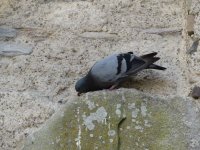marnixR
WYSIWYG
the attached picture was taken a few days ago in the Bishop's Palace at St. Davids, Pembrokeshire
it set me wondering why a feral pigeon would be pecking at the mortar of the palace walls - could it be because of some nutrient deficiency, or maybe there's some particular tasty lichen growing on them ?
it set me wondering why a feral pigeon would be pecking at the mortar of the palace walls - could it be because of some nutrient deficiency, or maybe there's some particular tasty lichen growing on them ?








